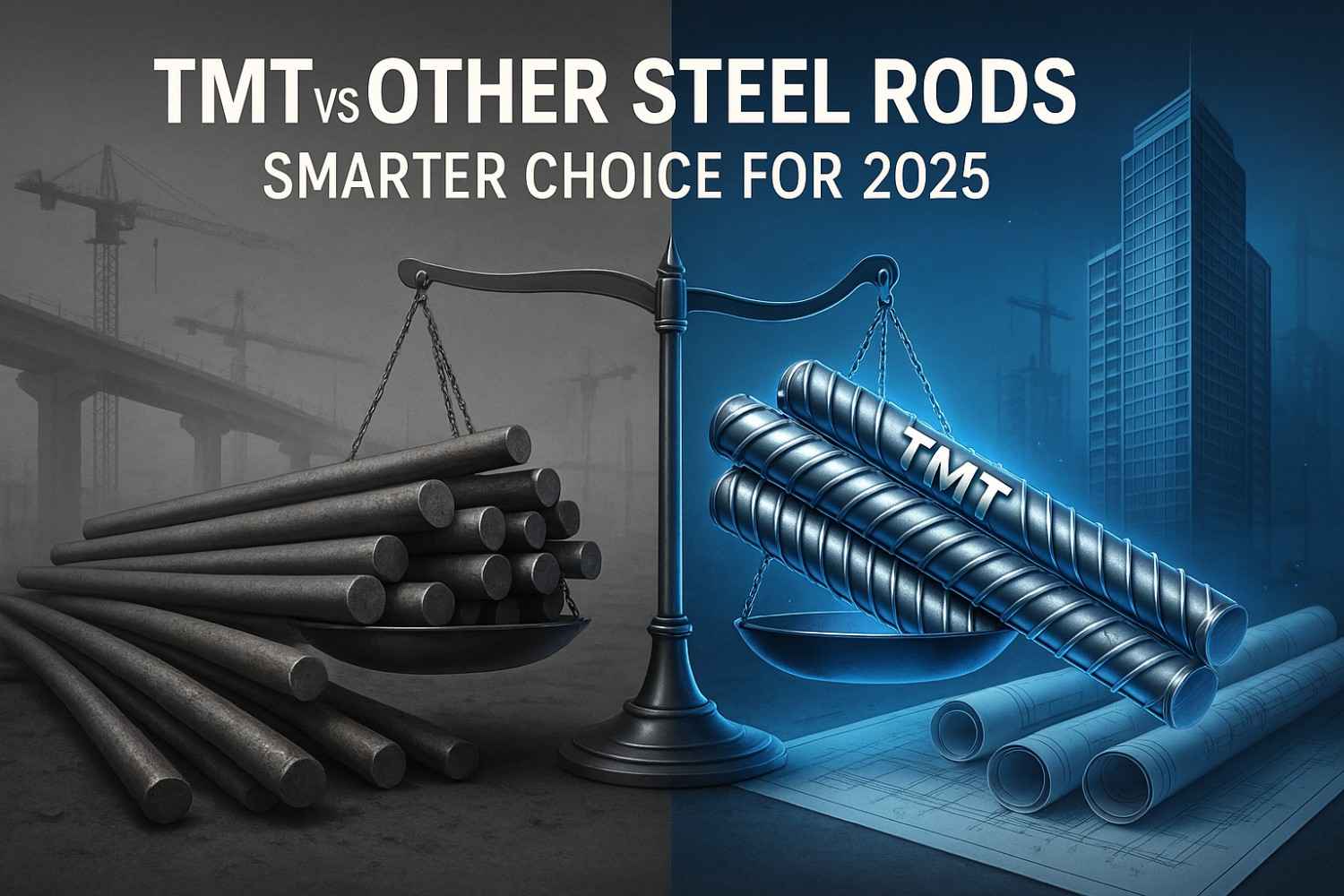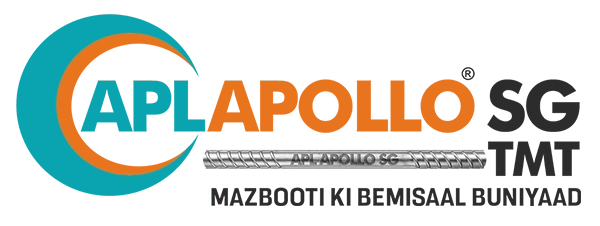
Introduction
India is in the middle of a massive construction boom. From metro rail corridors to skyscrapers and smart city housing, the demand for durable and safe building materials is at an all-time high. Yet, one recurring challenge persists: choosing the right reinforcement steel.
Many builders, contractors, and even homeowners often confuse TMT bars with conventional steel rods. While both are forms of reinforcement steel, their performance, longevity, and cost-effectiveness are vastly different. Using the wrong one can compromise safety and increase long-term costs.
As someone with over a decade of experience working alongside contractors and project managers, I’ve witnessed projects where poor steel choices led to structural cracks, rusting, and costly repairs. On the flip side, projects that chose TMT bars stood firm for decades with minimal maintenance.
In this guide, we’ll break down:
What TMT bars are and how they’re made.
What “other steel rods” mean in the Indian construction market.
A side-by-side comparison of TMT vs. steel rods.
Why modern builders and contractors are switching to TMT bars.
Real-world applications and grade selection tips.
Buying advice to avoid costly mistakes.

What Are TMT Bars?
Definition & Process
TMT stands for Thermo-Mechanically Treated steel bars. They are produced by passing hot steel billets through a series of cooling and heating processes, creating:
- A hard outer surface (for strength).
- A ductile inner core (for flexibility).
This unique structure allows TMT bars to withstand heavy loads, earthquakes, and corrosion, making them the preferred choice for modern RCC (reinforced concrete) construction.
Key Features of TMT Bars
- High Tensile Strength: 500–550 N/mm² depending on grade.
- Corrosion Resistance: Ribbed design prevents moisture accumulation.
- Earthquake Resistance: Flexibility allows energy absorption in seismic zones.
- Fire Resistance: Can withstand up to 600°C.
- Durability: Life span of 50+ years in normal conditions.
Common Grades:
- Fe 500: General RCC construction.
- Fe 550: High load-bearing structures.
- Fe 500D & Fe 550D (APL Apollo SG INFRA): High ductility for bridges, metros, and high-rise projects.
What Are Other Steel Rods?
In India, when people say “steel rods” or “saria,” they often refer to older types of reinforcement steel that predate TMT technology.
Types of Conventional Steel Rods
- Mild Steel (MS) Rods:
- Plain surface.
- Low strength (250–350 N/mm²).
- Corrodes easily.
- Cold Twisted Deformed (CTD) Bars:
- Popular before TMT bars entered the market.
- Manufactured by twisting MS rods to improve strength.
- Loses corrosion resistance due to surface stress.
- Plain Rebars:
- Used for small-scale construction.
- Weak grip with concrete.
Limitations of Steel Rods
- Prone to rusting and corrosion in humid environments.
- Lower tensile strength compared to TMT.
- Poor bonding with concrete (especially plain rods).
- Shorter lifespan (20–30 years).
- Outdated and rarely used in large projects post-2000.
TMT Bars vs. Other Steel Rods — A Direct Comparison
| Feature | TMT Bars (Fe 500, Fe 550) | Other Steel Rods (MS, CTD, Plain) |
|---|---|---|
| Strength | High (500–550 N/mm²) | Low–Medium (250–415 N/mm²) |
| Corrosion Resistance | Excellent (ribbed, treated) | Weak (prone to rust) |
| Flexibility | High (earthquake-resistant) | Low |
| Bonding with Concrete | Strong (ribbed surface) | Weak (smooth/plain surface) |
| Lifespan | 50+ years | 20–30 years |
| Cost | Slightly higher upfront | Cheaper initially |
| Maintenance Costs | Low | High (repairs & replacements) |
| Best Use | RCC buildings, bridges, infra | Small rural houses, low-load projects |

Why Smart Builders Prefer TMT Bars (2025 Perspective)
1. Compliance with Modern Codes
-
National Building Code (NBC) and BIS standards recommend TMT bars for seismic safety.
-
Builders can’t risk outdated materials in high-rise or infra projects.
2. Durability & Longevity
-
TMT bars resist corrosion even in coastal areas.
-
Suitable for bridges, ports, and humid regions.
3. Cost-Efficiency in the Long Run
-
Initial cost slightly higher but 25–30% savings over 30 years (reduced repairs).
4. Case Study: Metro Rail Projects
-
Delhi & Mumbai metro projects have used Fe 550D rebars extensively.
-
Contractors preferred TMT due to tight safety regulations.
Applications of TMT Bars in Construction
Residential Construction
-
Fe 500 TMT bars for homes, apartments, and small commercial projects.
-
Example: A 12mm TMT bar commonly used for slabs and beams.
Infrastructure Projects
-
Fe 550D rebars for bridges, highways, and metros.
-
Withstands heavy loads & seismic activity.
Industrial Projects
-
Used in factories, refineries, renewable energy structures.



How to Select the Right Grade of TMT Bar
-
Fe 500:
For general residential and RCC use. -
Fe 550:
For commercial complexes and medium-load structures. -
Fe 500D & Fe 550D (APL Apollo SG INFRA):
For infrastructure requiring higher ductility, e.g., metro stations, bridges, towers.
Tip: Builders should balance strength vs. ductility depending on project type.
Buying Tips for TMT Bars (Contractors & Builders)
-
Check Certifications:
-
BIS IS:1786 compliance.
-
-
Compare Daily Prices:
-
tmt saria price.
-
12mm rod price.
-
16mm steel bar price.
-
-
Insist on Mill Test Certificates:
-
Confirms grade & quality.
-
-
Source from Trusted Brands:
-
PAN-India distribution networks like APL Apollo TMT ensure consistency.
-
-
Negotiate Bulk Discounts:
-
For large projects, suppliers offer better rates.
-
Conclusion
The debate between TMT bars vs. steel rods is almost settled in 2025. For any serious construction—be it housing, infrastructure, or industrial projects—TMT bars clearly outperform conventional rods.
They offer higher strength, better durability, resistance to corrosion, and compliance with modern codes. While rods may still find limited use in small-scale rural projects, TMT is the undisputed standard for safe, modern, and future-ready construction.




